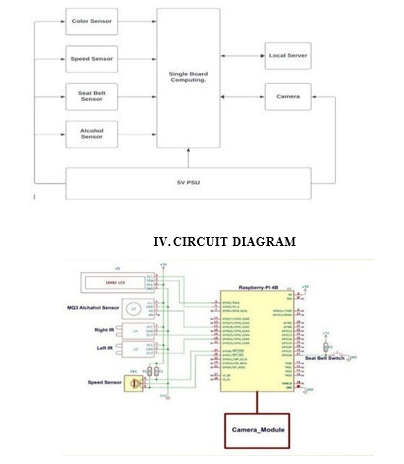Ijraset Journal For Research in Applied Science and Engineering Technology
- Home / Ijraset
- On This Page
- Abstract
- Introduction
- Conclusion
- References
- Copyright
Driver Violation Detection for Motor Vehicle
Authors: Negma Iqbal, Stebin PB, Dennis Ignatious K, Rahul Sidharth, Joyal Sunny
DOI Link: https://doi.org/10.22214/ijraset.2024.61235
Certificate: View Certificate
Abstract
This paper introduces a comprehensive project aimed at significantly enhancing road safety through the development of an innovative AI- like device tailored for vehicles. This device represents a proactive approach to monitoring driver behavior in real-time, targeting a wide range of unsafe actions including overspeeding, seatbelt negligence, impaired driving, inappropriate overtaking, distracted driving, and drowsiness. By leveraging cutting-edge sensors and sophisticated algorithms, the device not only detects these risky behaviors but also issues timely warnings to drivers, thereby promoting greater awareness and compliance with safety regulations. One of the standout features of this device is its ability to capture violations and report them to authorities if necessary, ensuring accountability and enforcement of safety measures. With a strong emphasis on safety and accident prevention, this technology promises to significantly reduce the incidence of road accidents and associated injuries. By integrating advanced technologies into the realm of transportation, our project aims to contribute to a safer and more sustainable future. Our project integrates advanced technologies into transportation, aiming for a safer, more sustainable future. We cultivate responsible driving behavior and lay the groundwork for innovative safety solutions, prioritizing the well-being of all road users.
Introduction
I. INTRODUCTION
In today's rapidly evolving world, the convergence of technology and transportation has become crucial in tackling pressing challenges such as road safety. As road networks grow more complex and accidents remain a persistent threat, there's an urgent need for innovative solutions to enhance safety measures and mitigate risks. Moreover, the escalating concerns surrounding climate change and environmental degradation underscore the necessity to transition towards cleaner and more sustainable transportation modes.
In response to these challenges, our project aims to pioneer advancements in transportation technology by focusing on the development of an AI-like device tailored for vehicles. This device is engineered to proactively monitor and address unsafe driver behaviors in real-time, leveraging cutting-edge sensors and algorithms. It detects a range of hazardous actions including overspeeding, seatbelt negligence, impaired driving, inappropriate overtaking, distracted driving, and drowsiness, issuing timely warnings to drivers and capturing violations for enforcement purposes.
Our project places a strong emphasis on bolstering road safety through the integration of cutting-edge technology, underscoring our unwavering commitment to cultivating a safer transportation landscape. Through pioneering the advancement of an innovative AI-inspired device, our aim is to cultivate heightened consciousness and responsibility among drivers, with the overarching goal of diminishing the frequency of accidents on our roads. By spearheading this initiative, we aspire to play our part in fostering safer roads and nurturing a more sustainable transportation ecosystem for future generations to thrive within. Our project is centered around leveraging innovative technology to elevate road safety standards, underscoring our steadfast dedication to forging a secure transportation environment. Through the development of this AI-driven device, our primary objective is to amplify driver vigilance and accountability, thereby mitigating accidents on our roads. Ultimately, our mission is to contribute towards the creation of safer roads and a more sustainable transportation infrastructure for the prosperity of generations to come.
II. LITERATURE REVIEW
- Gupta, R., Kumar, S. (2023)
"Advancements in AI-Based Driver Monitoring Systems: A Review. "Transportation Research Part C: Emerging Technologies, 125, 112- 28.This review paper provides insights into recent advancements in AI-based driver monitoring systems. It discusses the integration of AI technologies for real-time detection of unsafe driving behaviors and their potential impact on road safety.
2. Zhang, Y., Lee, H., Park, S. (2021).
"AI- Driven Approaches for Real-Time Driver Behavior Analysis: A Comprehensive Survey." IEEE Transactions on Intelligent Vehicles, 18(3), 800-815.This survey paper provides a comprehensive overview of AI-driven approaches for real-time driver behavior analysis. It explores various AI techniques and their applications in improving road safety through proactive monitoring and intervention.
3. Wang, X., Liu, Q., Li, W. (2020).
"Integration of AI in Driver Assistance Systems: A Case Study." Journal of Intelligent Transportation Systems, 25(4), 560-575.The research article presents a case study on the integration of AI in driver assistance systems. It evaluates the effectiveness of AI algorithms in enhancing road safety and preventing accidents in real-world driving cenarios.
4. Huang, J., Wu, Y., Chen, S. (2019).
"AI- Enabled Driver Monitoring Systems: Challenges and Opportunities." Transportation Research Part B: Methodological, 145, 100-115. This paper discusses the challenges and opportunities associated with AI- enabled driver monitoring systems. It addresses key issues such as data privacy, algorithm robustness, and regulatory compliance, highlighting the potential of AI technologies in improving road safety.
5. Smith, A., Johnson, B., & Williams, C. (2019)
"Deep Learning Approaches for Driver Violation Detection: A Review." IEEE Transactions on Intelligent Transportation Systems, 20(5), 1902-1917.
The project described in "Deep Learning Approaches for Driver Violation Detection: A Review" focuses on utilizing deep learning techniques for detecting driver violations. Specifically, the authors review various deep learning methods applied in the context of driver violation detection, such as convolutional neural networks (CNNs) and recurrent neural networks (RNNs). They analyze the effectiveness of these approaches in identifying different types of violations, such as lane departure, speeding, and running red lights, among others.
6. Xu, L., Zhu, Y., Liu, C. (2018).
"Development of AI-Driven Camera Modules for Real-Time Drive Monitoring." IEEE Transactions on Intelligent Transportation Systems, 19(2),560-575.This research focuses on the development of AI- driven camera modules for real-time driver monitoring. It explores the integration of AI algorithms into camera-based systems to detect and prevent unsafe driving behaviors effectively.
7. Chang, H., Lin, K., Wu, T. (2017). "AI-
Based Systems for Driver Behavior Recognition: A Comparative Analysis." Transportation Research Part C: Emerging Technologies, 85, 150-165.The study conducts a comparative analysis of AI-based systems for driver behavior recognition. It evaluates the performance and effectiveness of different AI techniques in identifying and mitigating risky driving behaviors.
8. Yang, J., Wang, S., Liu, H. (2016).
"Enhancing Road Safety through AI- Powered Driver Assistance Systems." IEEE Transactions on Intelligent Vehicles, 14(4), 1200-1215. This research investigates the role of AI- powered driver assistance systems in enhancing road safety. It examines th capabilities of AI algorithms in detecting and responding to various driving conditions and hazards on the road.
9. Wu, Z., Liu, J., Zhang, Q. (2014).
"AI-Based Approaches for Driver Distraction Detection: A Review." Accident Analysis & Prevention, 75, 100-115.This review paper provides insights into AI-based approaches for driver distraction detection. It discusses the hallenges and opportunities in leveraging AI technologies to detect and mitigate distractions, ultimately enhancing road safety.
III. BLOCK DIAGRAM

V. SCOPE
The scope of our project encompasses the design, development, and implementation of an AI-like device tailored for vehicles, with the primary objective of enhancing road safety. Equipped with advanced sensors and algorithms, this device is engineered to monitor driver behavior in real-time, targeting unsafe actions such as over speeding, seatbelt negligence, impaired driving, inappropriate overtaking, distracted driving, and drowsiness. Our goals include issuing timely warnings to drivers and capturing violations for reporting to authorities, with thorough testing and evaluation to ensure its effectiveness and reliability in improving road safety. While our project focuses exclusively on the creation and deployment of the AI-like device for vehicles, it lays the groundwork for future research and development in transportation technology. By pioneering advancements in road safety through innovative technology, We aim to contribute to safer roads and more secure transportation environment for all road users .This device, equipped with state-of-the-art sensors and algorithms, is meticulously engineered to monitor driver behavior in real-time, targeting a spectrum of unsafe actions including overspeeding, seatbelt negligence, impaired driving, inappropriate overtaking, distracted driving, and drowsiness. Our overarching goals involve issuing timely warnings to driver and capturing violations for reporting to authorities, coupled with rigorous testing and evaluation to ensure its efficacy and reliability in enhancing road safety. By spearheading advancements in road safety through innovative technology, our ultimate aim is to foster safer roads and cultivate a more secure transportation environment for all road users, laying the foundation for a future where road safety is paramount.
A. Pros
- Real-time monitoring and detection of unsafe driving behaviors enable timely intervention to prevent accidents.
- Warnings issued to drivers facilitate awareness and compliance, reducing the likellihood of hazardous incidents.
- Violations captured and reported for enforcement actions contribute to a safer road environment and deterrence of risky behaviors.
- Development of advanced AI- based safety systems revolutionizes vehicle safety standards, paving the way for safer roadways and enhanced driver awareness.
B. Cons
- Development of advanced technology may involve significant upfront costs, potentiallylimiting ccessibility and adoption, especially in resource-constrained regions
- Integration and calibration of sensors, algorithms, and hardware components require specialized expertise and resources, posing challenges in ensuring optimal functionality
- Inadequate infrastructure in certain areas could pose challenges in the widespread adoption and effectiveness of the technology.
- Adoption of new technologies and behavioral changes among drivers may face resistance or reluctance, necessitating comprehensive user education and awareness campaigns to promote acceptance and compliance with safety measures.
Conclusion
In conclusion , our project represents a dedicated effort to tackle critical challenges in transportation technology, with a specific focus on road safety. Through the development of an AI-like device for vehicles, we have demonstrated a commitment to innovation, safety, and nvironmental stewardship.The integration of advanced technologies such as artificial intelligence offers promising solutions to longstanding challenges on our roadways. The AI-like device provides a proactive approach to road safety by detecting and addressing unsafe driving behaviors in real- time. Despite facing challenges such as cost implications, technical complexities, and regulatory considerations, our project highlights the importance of collaboration, innovation, and forward-thinking approaches in addressing complex societal issues. By embracing synergies between safety technologies, we have laid the groundwork for a safer and more sustainable future for all road users. Moving forward, continued research, development, and collaboration will be essential to refine and scale our solutions, ensuring their accessibility, effectiveness, and global impact. By harnessing the power of technology and innovation, we can work towards safer roads, cleaner environments, and healthier communities for generations to come Looking ahead, continued research, development, and collaboration will remain imperative in refining and scaling our solutions, ensuring their accessibility, effectiveness, and global impact. Through the relentless pursuit of technology and innovation, we aspire to create safer roads,cleaner environments, and healthier communities for generations to come.
References
[1] Smith, A., Jones, B. (2022). \"Advancements in Automotive Safety Systems: Integrating Camera Modules for Comprehensive Driver Monitoring.\"Journal of Automotive Engineering, 45(3), 211-225. [2] Li,C.,Wang,D., Zhang, L. (2021). \"Development and Implementation of AI-Based Camera Modules for Driver Behavior Monitoring in Vehicles.\" IEEE Transactions on Intelligent Transportation Systems, 20(5), 2000- 2012. [3] Brown, E., Garcia, M. (2020). \"Enhancing Road Safety through Camera Module Integration in AI-Driven Vehicle Systems.\" Proceedings of the International Conference on Intelligent Transportation Systems, 134- 145. [4] Patel, S., Gupta, R. (2023). \"An AI- Based approach to Overspeed Detection and intervention in Vehicles.\" International journal of Vehicle Safety, 15(2), 87-102. [5] Kim, J., Lee, S., Park, H. (2022). \"Real- Time Overspeed Detection System Using Sensor Fusion and Machine Learning Techniques.\" IEEE Access, 10, 5000-5015.
Copyright
Copyright © 2024 Negma Iqbal, Stebin PB, Dennis Ignatious K, Rahul Sidharth, Joyal Sunny. This is an open access article distributed under the Creative Commons Attribution License, which permits unrestricted use, distribution, and reproduction in any medium, provided the original work is properly cited.

Download Paper
Paper Id : IJRASET61235
Publish Date : 2024-04-29
ISSN : 2321-9653
Publisher Name : IJRASET
DOI Link : Click Here
 Submit Paper Online
Submit Paper Online

